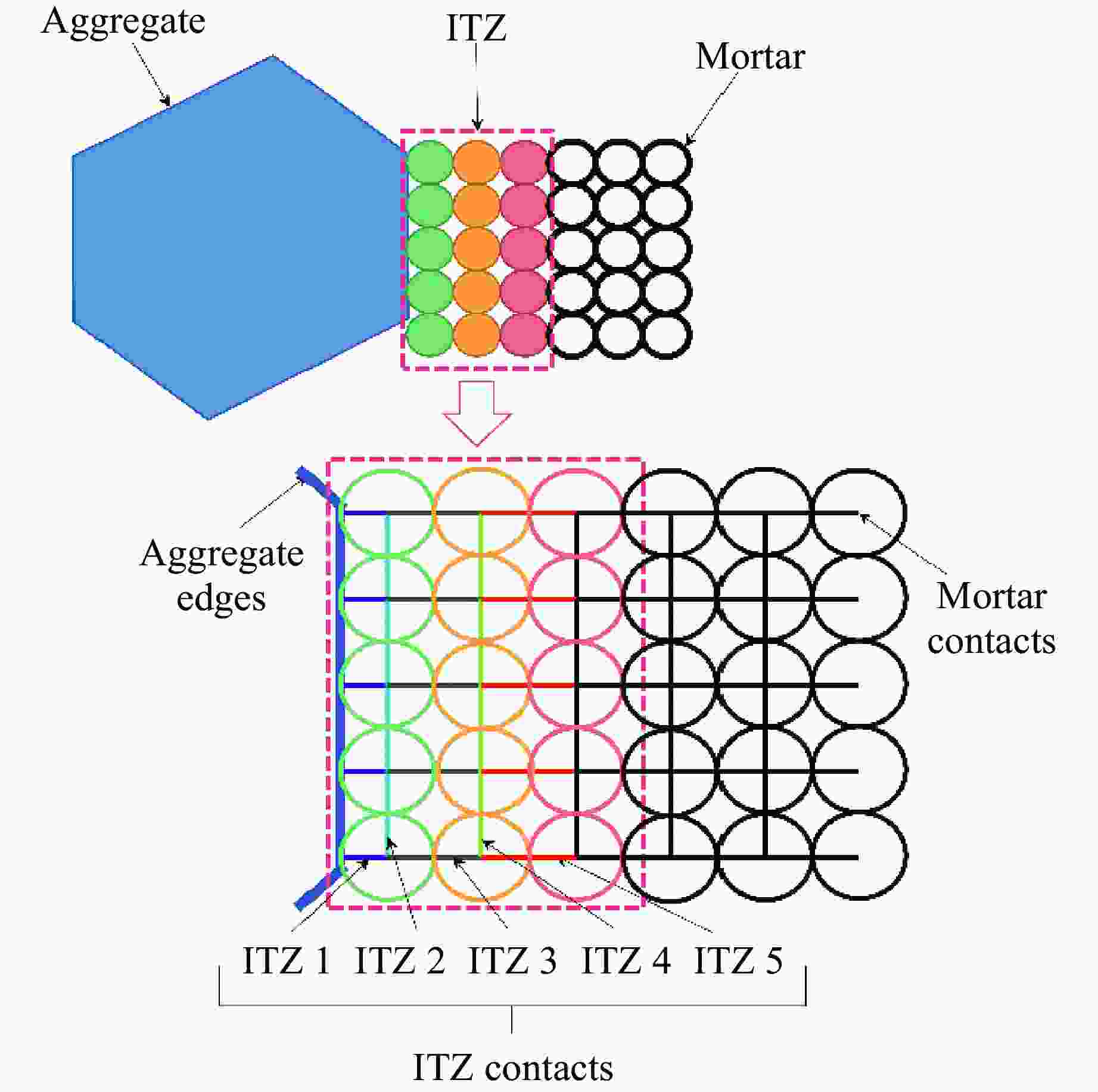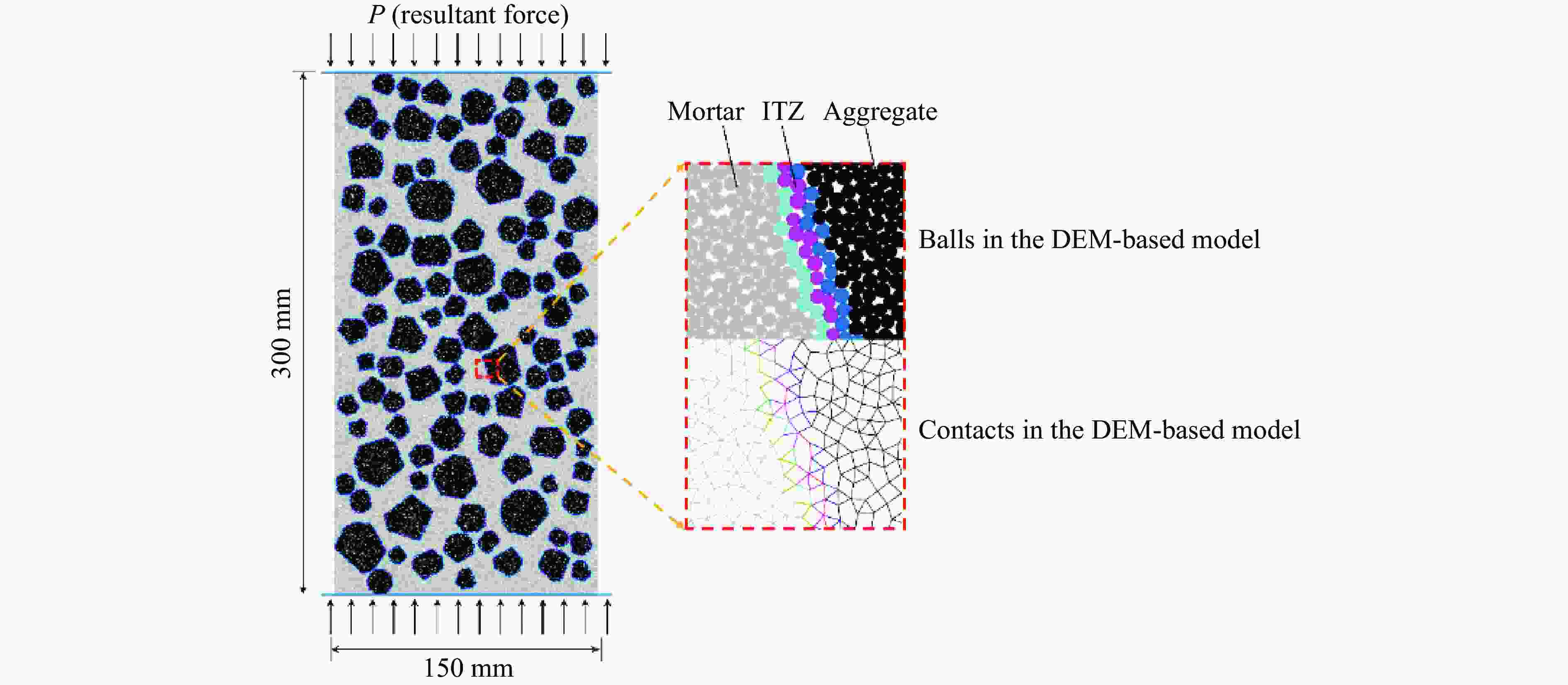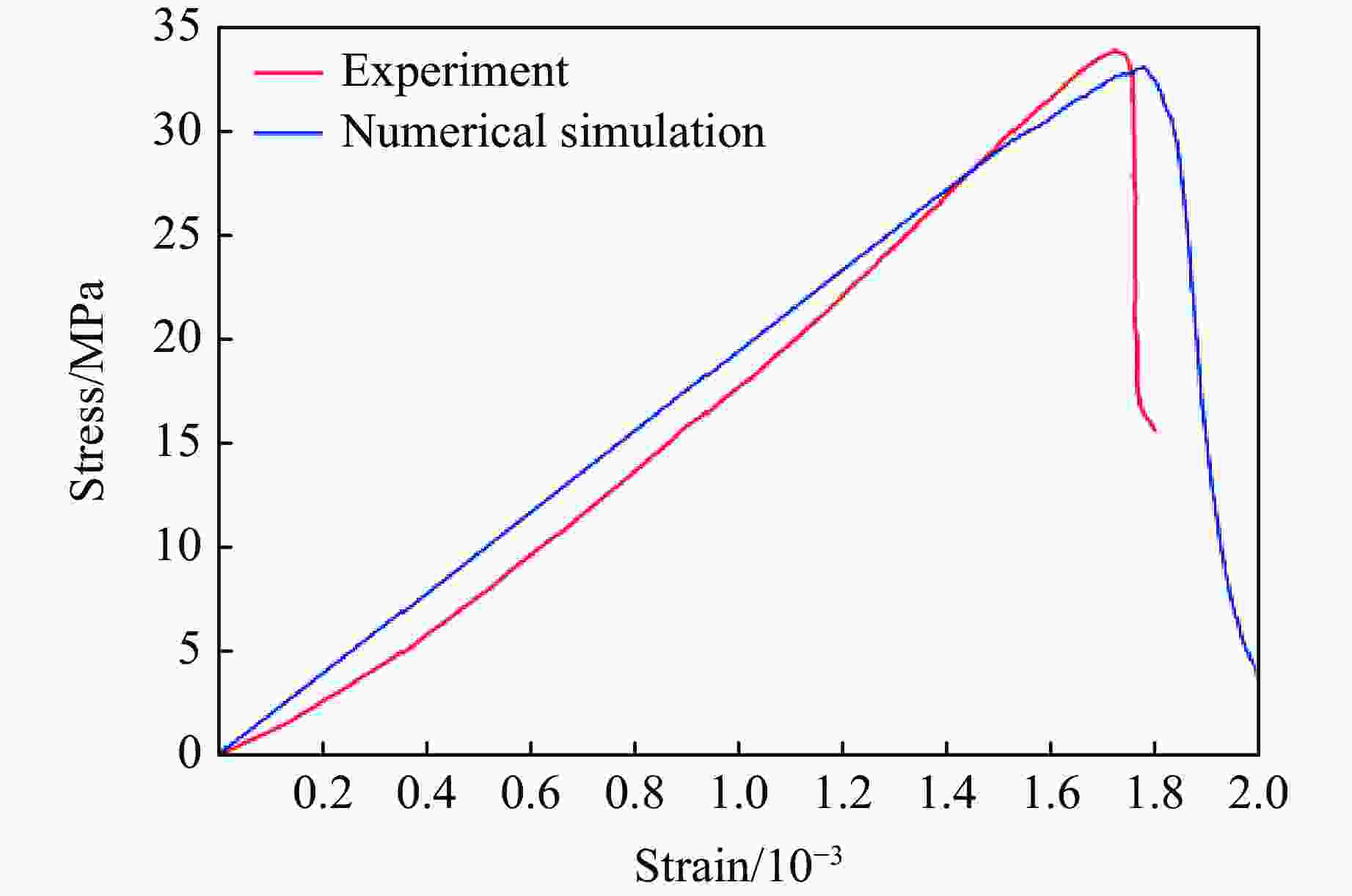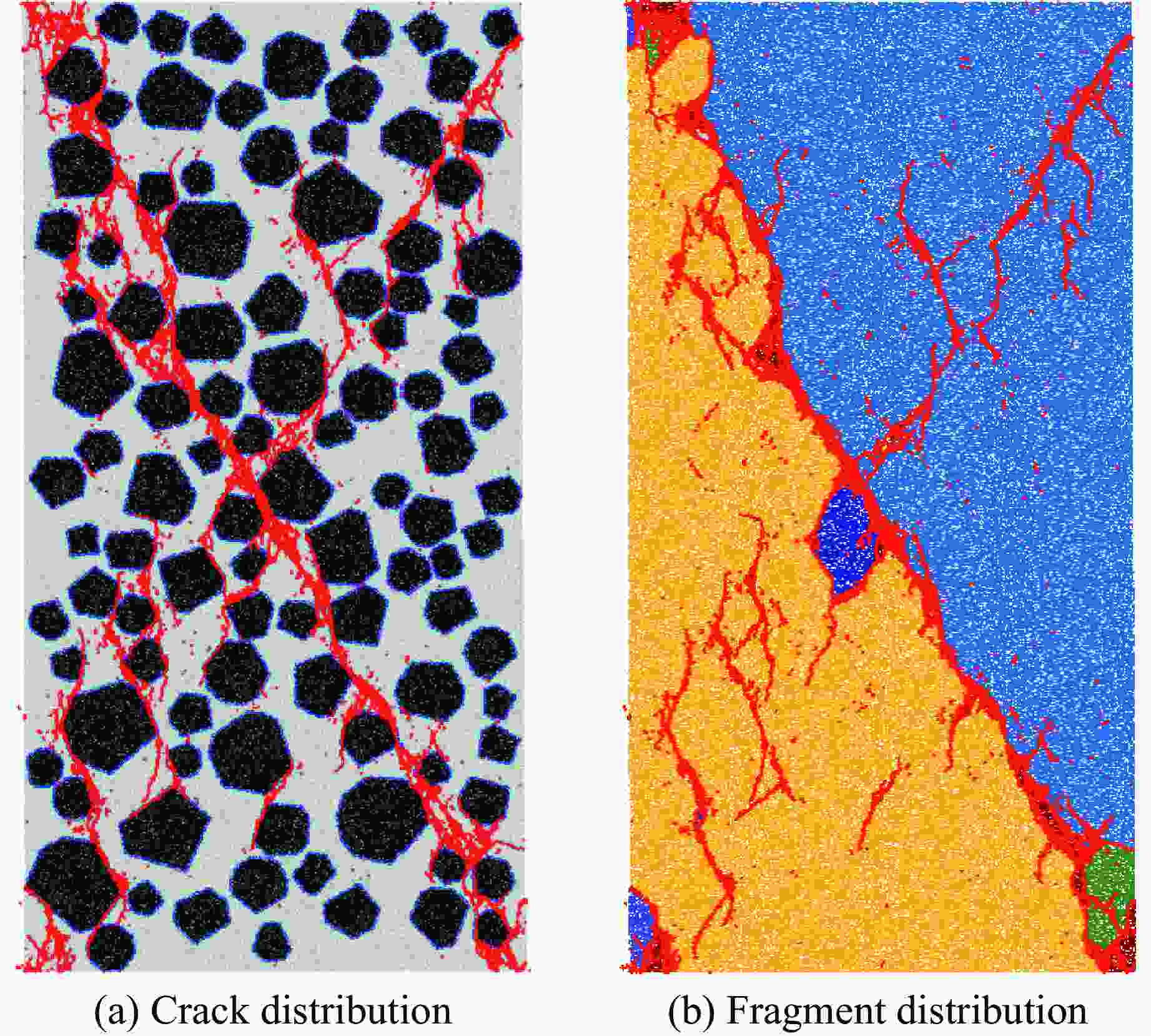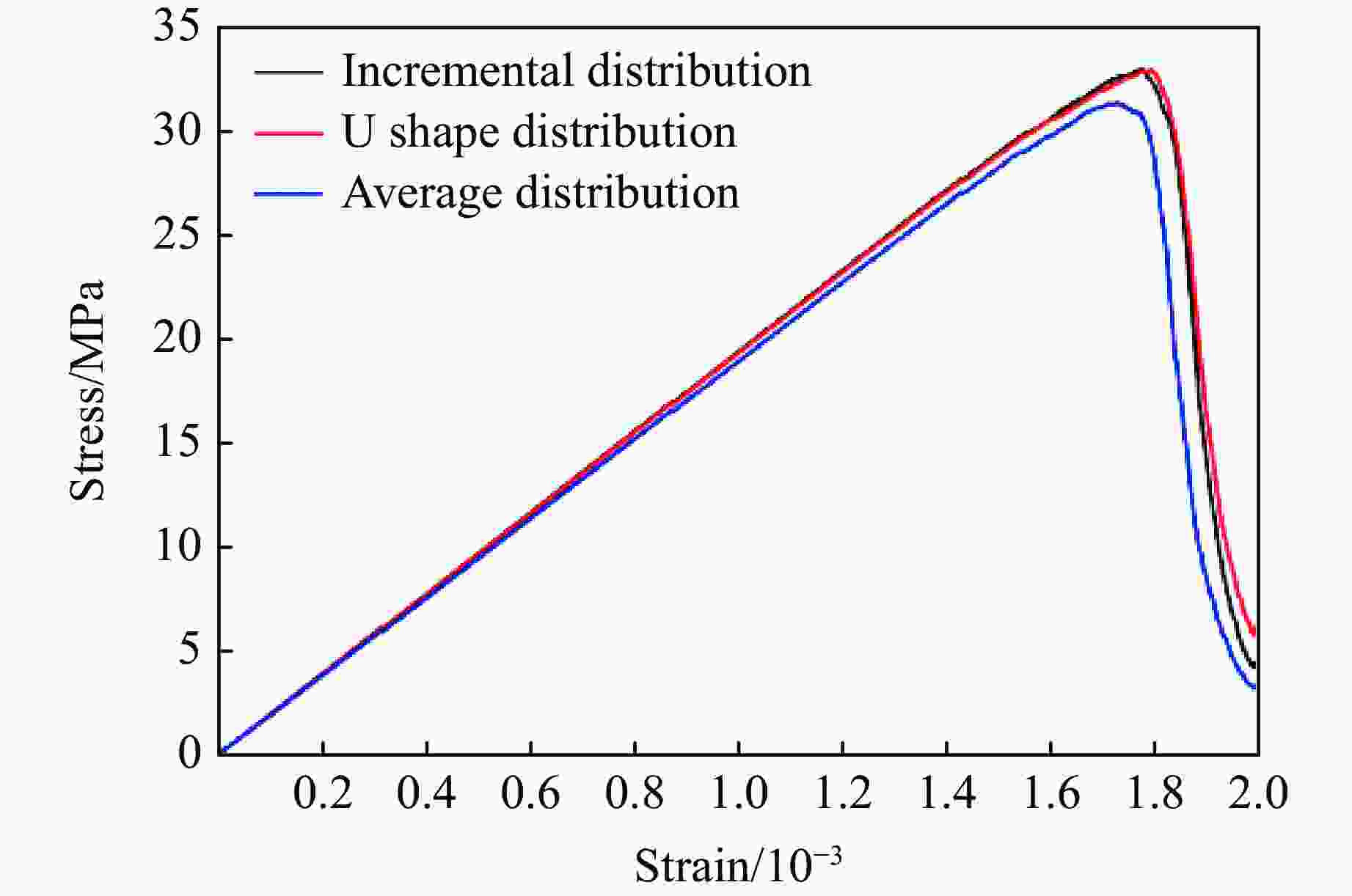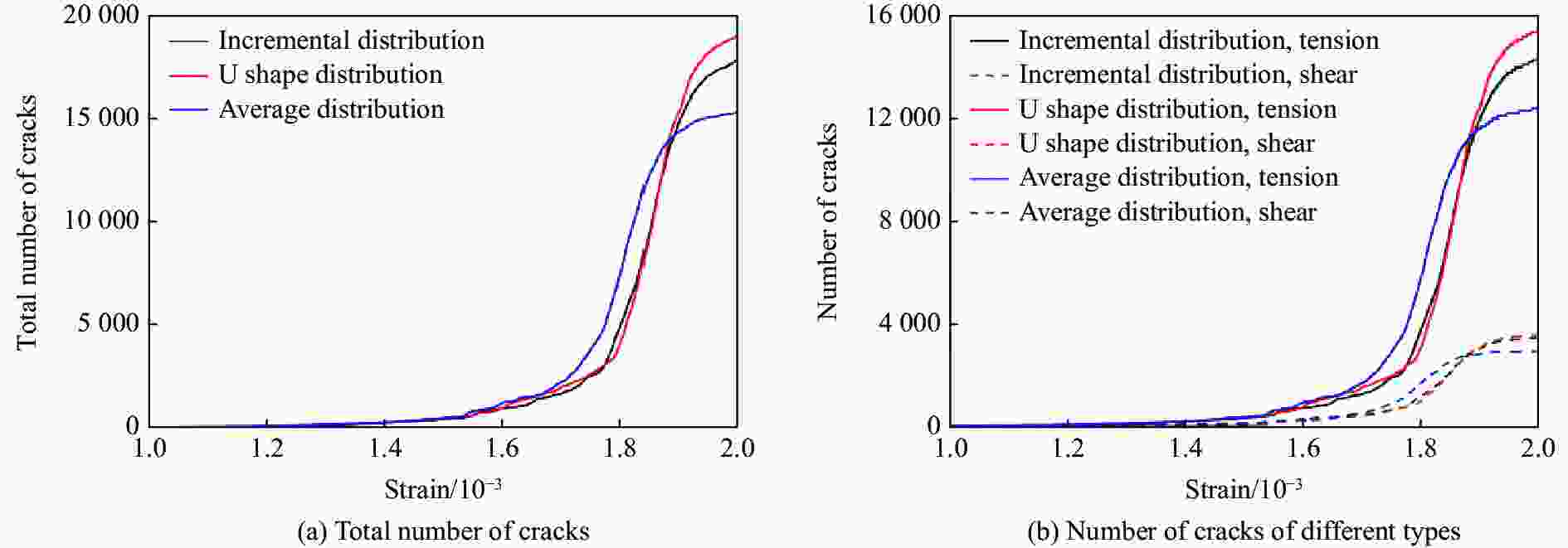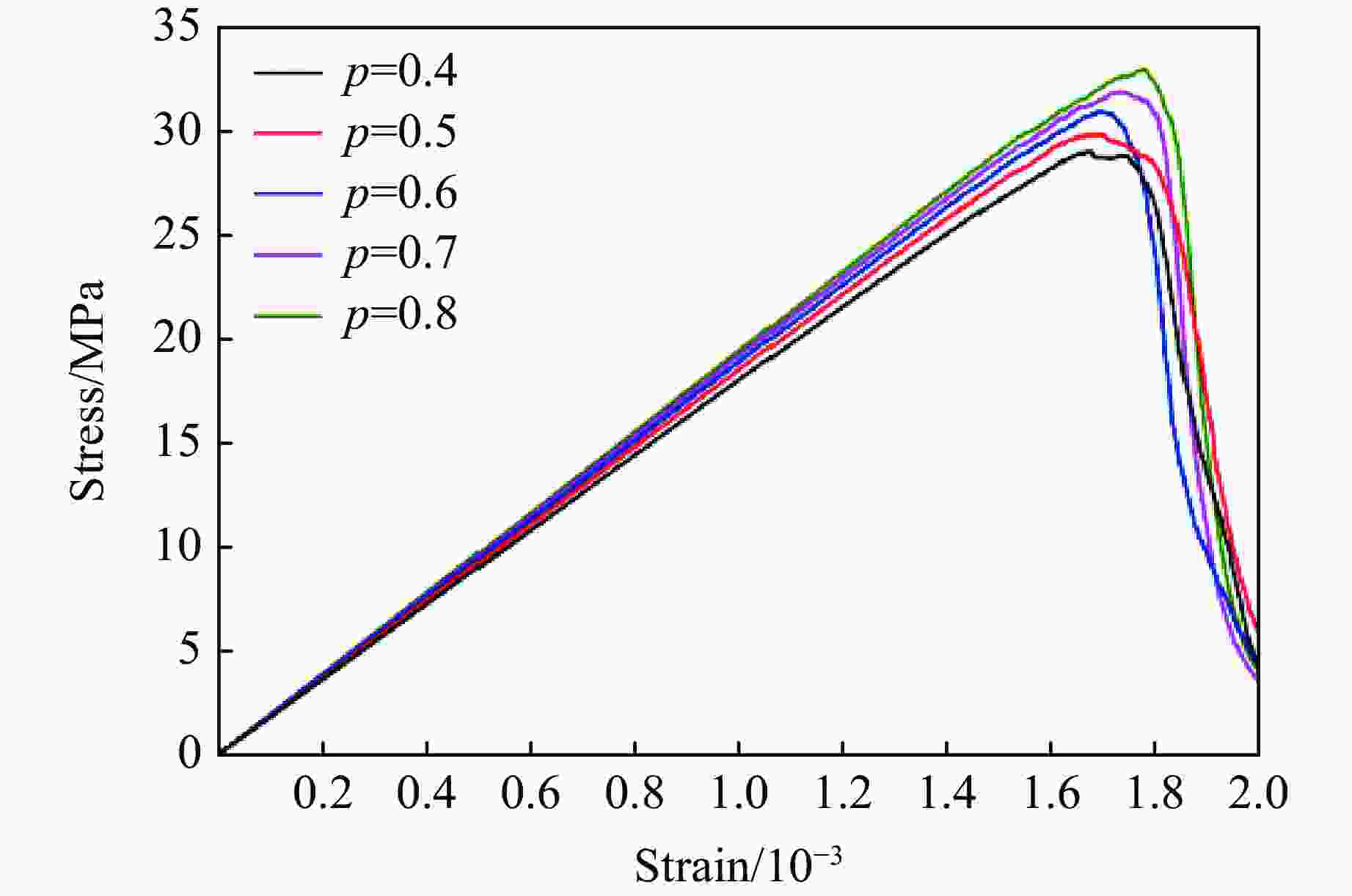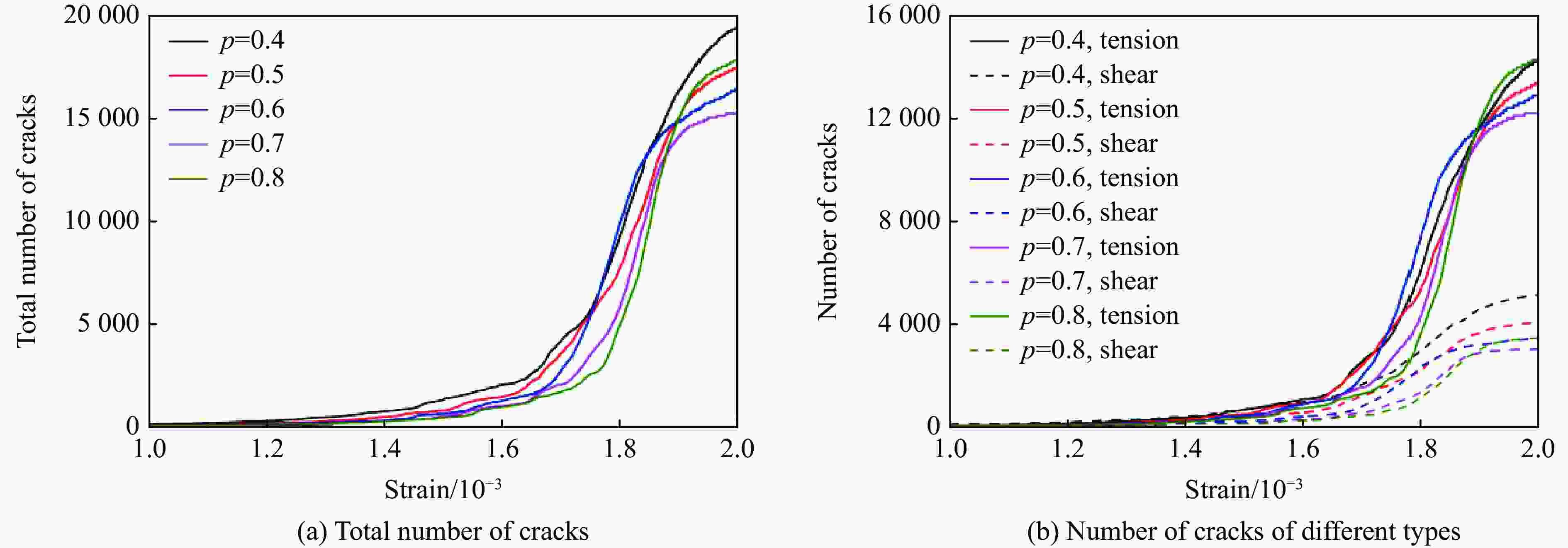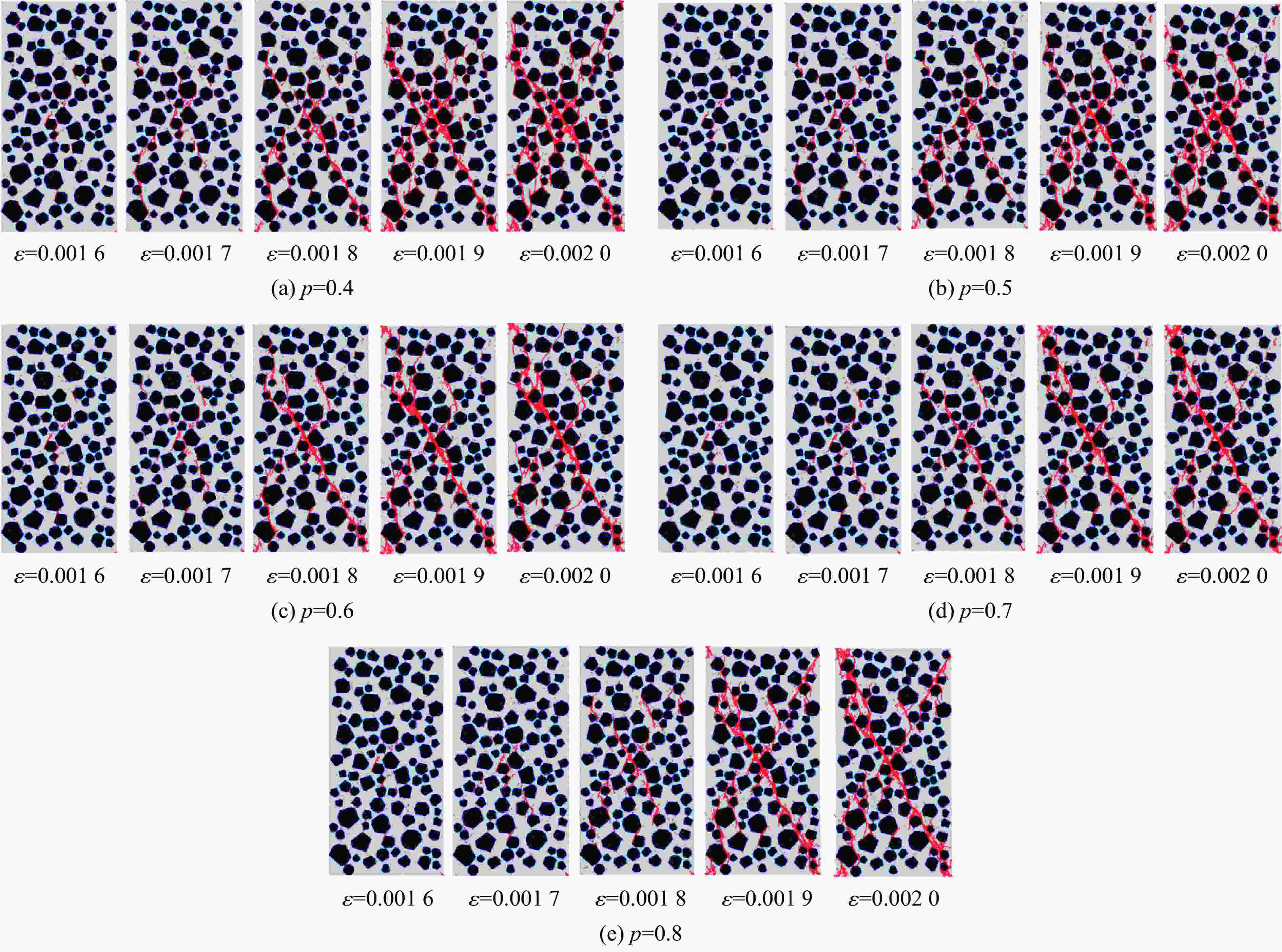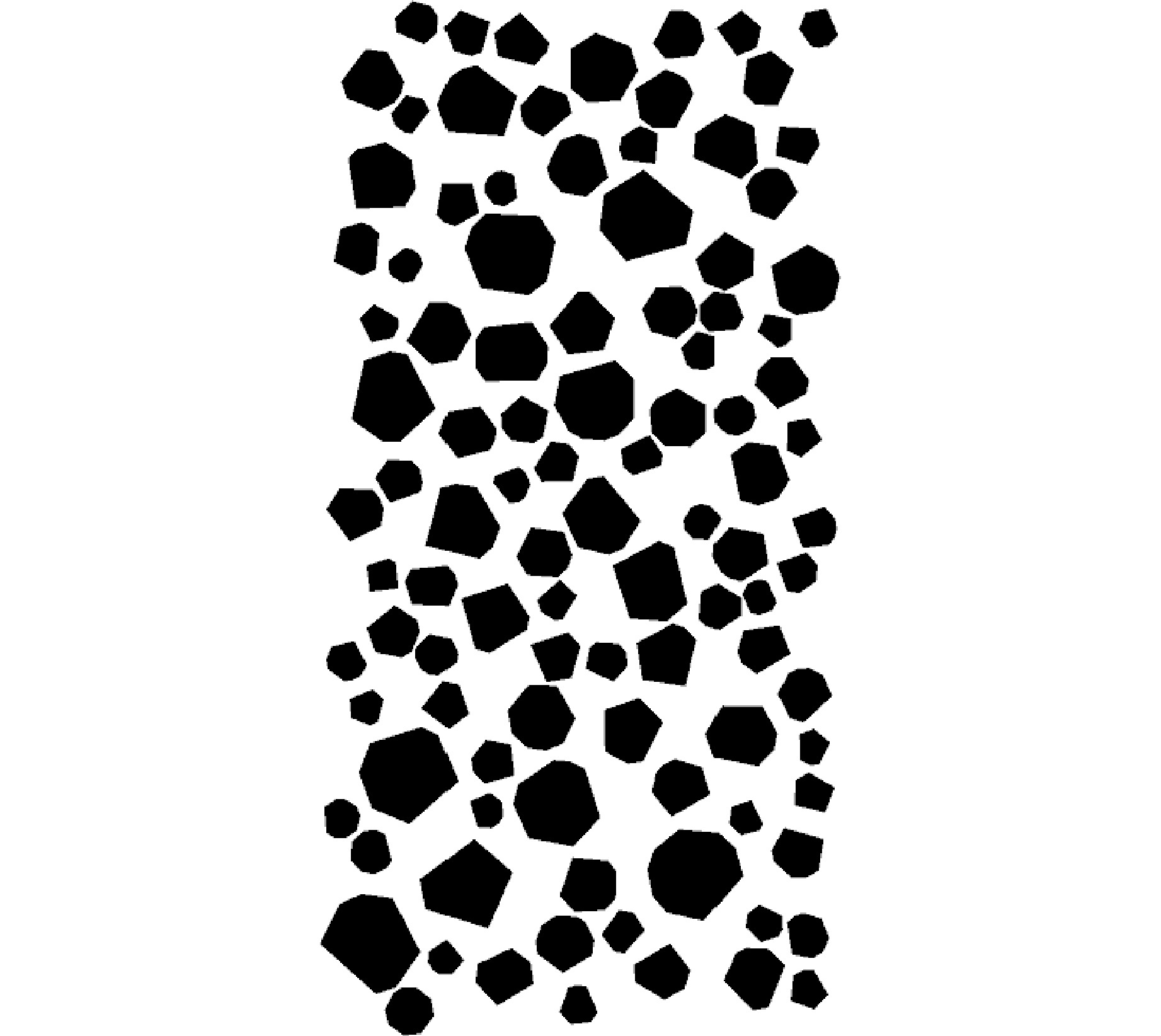Influence of Interfacial Transition Zone on Crack Propagation Process in Concrete
-
摘要: 混凝土是由水泥砂浆、粗骨料和界面过渡区(interfacial transition zone, ITZ)组成的非均质复合材料。ITZ作为混凝土内部的最薄弱相,对混凝土的宏观断裂有重要影响。基于PFC 2D的FISH语言,建立了能反映混凝土骨料、水泥砂浆和ITZ等复杂细观结构的离散元模型,并探讨了在单轴压缩载荷下ITZ强度分布和强度值对混凝土裂纹扩展过程的影响。数值模拟结果表明:混凝土裂纹遵循从中心向加载端扩展的趋势,超过80%的裂纹出现在峰值应力后的软化阶段;ITZ强度分布对混凝土裂纹扩展过程影响较弱,当ITZ强度呈现U形分布时,混凝土中裂纹数量较多;ITZ强度值对混凝土断裂程度及最终断裂形式影响显著,当ITZ的最小黏结强度与砂浆黏结强度比p<0.5时,混凝土强度显著降低,且裂纹围绕混凝土模型中心分散扩展形成网状宏观裂纹,导致试件发生散碎破坏,当p>0.6时,裂纹从混凝土试样中心向加载端集中扩展形成宏观贯通裂纹,导致试件发生块状破坏。Abstract: Concrete is a heterogeneous composite material composed of coarse aggregate, mortar and interfacial transition zone (ITZ). ITZ is the weakest phase inside the concrete and has a significant effect on the macroscopic fracture process of concrete. To respectively explore the effects of the distribution and value of ITZ strength on the crack propagation process in concrete under uniaxial compression, a discrete element model that reflects complex mesostructures of concrete aggregate, mortar and ITZ is established in PFC 2D by the use of FISH code. The numerical simulation results showed that cracks follow the propagation order from the centre of concrete to the loading end during the crack propagation process, and more than 80% of cracks appear in the softening stage after peak stress. The ITZ strength distribution has a weak effect on the crack propagation process in concrete, and the number of cracks in concrete is large when the ITZ strength shows a U shape distribution. The decrease in ITZ strength value leads to a gradual increase in the number and range of cracks. When the ratio of the minimum bond strength of ITZ to the bond strength of mortar p<0.5, the concrete strength is significantly reduced and the cracks expand around the centre of the concrete model to form a network macro-crack, resulting in scattered fracture failure. When p>0.6, the cracks expand from the centre of the concrete specimen to the loading end to form a macroscopic penetration crack, resulting in block fracture failure.
-
Key words:
- concrete /
- interfacial transition zone /
- discrete element method /
- mesoscale model /
- crack propagation
-
表 1 不同ITZ强度分布下ITZ与砂浆的强度比
Table 1. Strength ratio of ITZ to mortar for different ITZ strength distributions
Distribution mode ITZ layer σITZ/σmortar Distribution mode ITZ layer σITZ/σmortar Incremental distribution ITZ 1 0.80 Average distribution ITZ 1 0.80 ITZ 2 0.86 ITZ 2 0.80 ITZ 3 0.90 ITZ 3 0.80 ITZ 4 0.94 ITZ 4 0.80 ITZ 5 0.98 ITZ 5 0.80 U shape distribution ITZ 1 0.90 ITZ 2 0.85 ITZ 3 0.80 ITZ 4 0.90 ITZ 5 0.98 表 2 5组模型中ITZ与砂浆的强度比
Table 2. Strength ratio of ITZ to mortar for 5 groups of models
Model p ITZ layer σITZ/σmortar 1 0.40 ITZ 1 0.40 ITZ 2 0.65 ITZ 3 0.80 ITZ 4 0.90 ITZ 5 0.98 2 0.50 ITZ 1 0.50 ITZ 2 0.70 ITZ 3 0.83 ITZ 4 0.91 ITZ 5 0.98 3 0.60 ITZ 1 0.60 ITZ 2 0.75 ITZ 3 0.85 ITZ 4 0.92 ITZ 5 0.98 4 0.70 ITZ 1 0.70 ITZ 2 0.80 ITZ 3 0.88 ITZ 4 0.93 ITZ 5 0.98 5 0.80 ITZ 1 0.80 ITZ 2 0.86 ITZ 3 0.90 ITZ 4 0.94 ITZ 5 0.98 表 3 接触细观参数
Table 3. Meso-parameters of contacts
Material Ec/GPa k* μ λ σt/MPa C/MPa φ/(°) Aggregate 100 1.5 0.3 1 1000 1000 45 Mortar 10 1.5 0.3 1 20 20 45 -
[1] 陈惠苏, 孙伟, PIET S. 水泥基复合材料集料与浆体界面研究综述(Ⅱ): 界面微观结构的形成、劣化机理及其影响因素 [J]. 硅酸盐学报, 2004, 32(1): 70–79. doi: 10.3321/j.issn:0454-5648.2004.01.013CHEN H S, SUN W, PIET S. Interfacial transition zone between aggregate and paste in cementitious composites (Ⅱ): mechanism of formation and degradation of interfacial transition zone microstructure, and its influence factors [J]. Journal of the Chinese Ceramic Society, 2004, 32(1): 70–79. doi: 10.3321/j.issn:0454-5648.2004.01.013 [2] DIAMOND S, HUANG J D. The ITZ in concrete–a different view based on image analysis and SEM observations [J]. Cement and Concrete Composites, 2001, 23(2/3): 179–188. doi: 10.1016/S0958-9465(00)00065-2 [3] OLLIVIER J P, MASO J C, BOURDETTE B. Interfacial transition zone in concrete [J]. Advanced Cement Based Materials, 1995, 2(1): 30–38. doi: 10.1016/1065-7355(95)90037-3 [4] 徐晶, 王先志. 纳米二氧化硅对混凝土界面过渡区的改性机制及其多尺度模型 [J]. 硅酸盐学报, 2018, 46(8): 1053–1058. doi: 10.14062/j.issn.0454-5648.2018.08.02XU J, WANG X Z. Effect of nano-silica modification on interfacial transition zone in concrete and its multiscale modelling [J]. Journal of the Chinese Ceramic Society, 2018, 46(8): 1053–1058. doi: 10.14062/j.issn.0454-5648.2018.08.02 [5] LEE K M, PARK J H. A numerical model for elastic modulus of concrete considering interfacial transition zone [J]. Cement and Concrete Research, 2008, 38(3): 396–402. doi: 10.1016/j.cemconres.2007.09.019 [6] 王力晓, 陈启东, 刘鑫. 超声动态载荷下混凝土过渡区域的损伤演化 [J]. 高压物理学报, 2020, 34(4): 044205. doi: 10.11858/gywlxb.20190833WANG L X, CHEN Q D, LIU X. Damage evolution in concrete interfacial transition zone with ultrasonic dynamic load [J]. Chinese Journal of High Pressure Physics, 2020, 34(4): 044205. doi: 10.11858/gywlxb.20190833 [7] MALEKI M, RASOOLAN I, KHAJEHDEZFULY A, et al. On the effect of ITZ thickness in meso-scale models of concrete [J]. Construction and Building Materials, 2020, 258: 119639. doi: 10.1016/j.conbuildmat.2020.119639 [8] NITKA M, TEJCHMAN J. Meso-mechanical modelling of damage in concrete using discrete element method with porous ITZs of defined width around aggregates [J]. Engineering Fracture Mechanics, 2020, 231: 107029. doi: 10.1016/j.engfracmech.2020.107029 [9] 杜修力, 金浏. 非均质混凝土材料破坏的三维细观数值模拟 [J]. 工程力学, 2013, 30(2): 82–88. doi: 10.6052/j.issn.1000-4750.2011.07.0445DU X L, JIN L. Numerical simulation of three-dimensional meso-mechanical model for damage process of heterogeneous concrete [J]. Engineering Mechanics, 2013, 30(2): 82–88. doi: 10.6052/j.issn.1000-4750.2011.07.0445 [10] 朱万成, 赵启林, 唐春安, 等. 混凝土断裂过程的力学模型与数值模拟 [J]. 力学进展, 2002, 32(4): 579–598. doi: 10.3321/j.issn:1000-0992.2002.04.012ZHU W C, ZHAO Q L, TANG C A, et al. Mechanical model and numerical simulation of fracture process of concrete [J]. Advances in Mechanics, 2002, 32(4): 579–598. doi: 10.3321/j.issn:1000-0992.2002.04.012 [11] CHIAIA B, VERVUURT A, VAN MIER J G M. Lattice model evaluation of progressive failure in disordered particle composites [J]. Engineering Fracture Mechanics, 1997, 57(2/3): 301–318. doi: 10.1016/S0013-7944(97)00011-8 [12] 刘光廷, 王宗敏. 用随机骨料模型数值模拟混凝土材料的断裂 [J]. 清华大学学报(自然科学版), 1996, 36(1): 84–89. doi: 10.16511/j.cnki.qhdxxb.1996.01.014LIU G T, WANG Z M. Numerical simulation study of fracture of concrete materials using random aggregate model [J]. Journal of Tsinghua University (Science and Technology), 1996, 36(1): 84–89. doi: 10.16511/j.cnki.qhdxxb.1996.01.014 [13] YU Y, ZHENG Y, ZHAO X Y. Mesoscale modeling of recycled aggregate concrete under uniaxial compression and tension using discrete element method [J]. Construction and Building Materials, 2021, 268: 121116. doi: 10.1016/j.conbuildmat.2020.121116 [14] 刘建南, 张昌锁. 过渡区界面对混凝土劈裂性能影响的试验与数值模拟 [J]. 科学技术与工程, 2018, 18(18): 269–274. doi: 10.3969/j.issn.1671-1815.2018.18.044LIU J N, ZHANG C S. Experiment and numerical simulation on the influence of interfacial transition zone on concrete splitting performance [J]. Science Technology and Engineering, 2018, 18(18): 269–274. doi: 10.3969/j.issn.1671-1815.2018.18.044 [15] 施惠生, 居正慧, 郭晓潞, 等. ITZ形成机制及其对混凝土力学性能与传输性能的影响 [J]. 建材技术与应用, 2014(6): 11–18. doi: 10.3969/j.issn.1009-9441.2014.06.006SHI H S, JU Z H, GUO X L, et al. ITZ formation mechanism and its influence on mechanical and transportation performance of concrete [J]. Research and Application of Building Materials, 2014(6): 11–18. doi: 10.3969/j.issn.1009-9441.2014.06.006 [16] LYU K, GARBOCZI E J, SHE W, et al. The effect of rough vs. smooth aggregate surfaces on the characteristics of the interfacial transition zone [J]. Cement and Concrete Composites, 2019, 99: 49–61. doi: 10.1016/j.cemconcomp.2019.03.001 [17] HE J T, LEI D, DI LUZIO G, et al. Mechanical properties measurement and micro-damage characterization of ITZ in concrete by SEM-DIC method [J]. Optics and Lasers in Engineering, 2022, 155: 107064. doi: 10.1016/j.optlaseng.2022.107064 [18] POTYONDY D O, CUNDALL P A. A bonded-particle model for rock [J]. International Journal of Rock Mechanics and Mining Sciences, 2004, 41(8): 1329–1364. doi: 10.1016/j.ijrmms.2004.09.011 [19] REN H L, SONG S Z, NING J G. Damage evolution of concrete under tensile load using discrete element modeling [J]. Theoretical and Applied Fracture Mechanics, 2022, 122: 103622. doi: 10.1016/j.tafmec.2022.103622 [20] 过镇海, 张秀琴, 张达成, 等. 混凝土应力-应变全曲线的试验研究 [J]. 建筑结构学报, 1982, 3(1): 1–12. doi: 10.14006/j.jz.jgxb.1982.01.001GUO Z H, ZHANG X Q, ZHANG D C, et al. Experimental investigation of the complete stress-strain curve of concrete [J]. Journal of Building Structures, 1982, 3(1): 1–12. doi: 10.14006/j.jz.jgxb.1982.01.001 [21] VARGAS P, RESTREPO-BAENA O, TOBÓN J I. Microstructural analysis of interfacial transition zone (ITZ) and its impact on the compressive strength of lightweight concretes [J]. Construction and Building Materials, 2017, 137: 381–389. doi: 10.1016/j.conbuildmat.2017.01.101 -






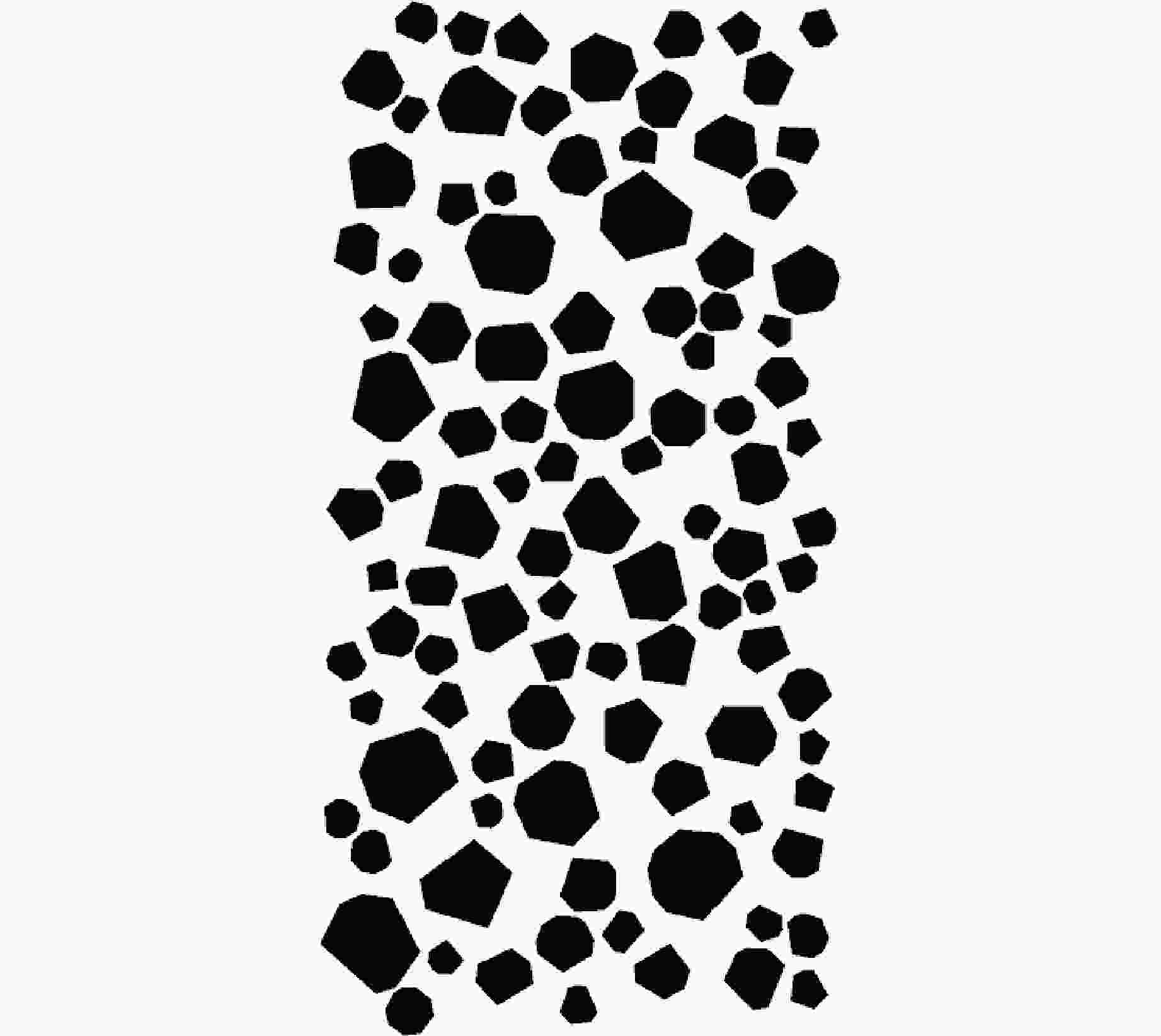
 下载:
下载:
